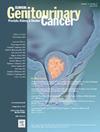临床淋巴结阳性膀胱癌患者行根治性膀胱切除术的预后意义。
IF 2.7
3区 医学
Q3 ONCOLOGY
引用次数: 0
摘要
临床淋巴结阳性(cN+)膀胱癌(BCa)患者形成了一个生物学和预后多样化的群体。由于全身治疗重塑了这种情况下的治疗,本研究检查了根治性膀胱切除术(RC)伴或不伴围手术期全身治疗后的肿瘤预后。材料和方法:我们使用了一个多中心、回顾性收集的1067例诊断为cTanyN+M0 BCa的患者的数据库,这些患者接受了RC伴淋巴结切除术,伴或不伴围手术期全身治疗。纳入了2006年至2023年期间接受治疗的cN1-2疾病患者。3个月里程碑Kaplan-Meier曲线用于估计总生存期(OS)。3个月里程碑竞争风险累积发生率曲线用于估计癌症特异性死亡率(CSM)。采用多变量Cox回归模型(MCR)评估治疗和病理反应(完全缓解[pCR]、部分缓解[pPR]和pN0)与任何原因死亡和癌症特异性死亡的关系。结果:589例患者符合纳入标准,其中术前全身治疗(PST) 189例(32%),RC +辅助治疗(AT) 115例(20%)。中位随访时间为32个月。PST + RC组3年OS为69%,RC + AT组为55%,RC单独组为55%。PST + RC (HR: 0.67, P = 0.042)与MCR全因死亡风险较低相关。PST + RC的3年CSM为28%,RC + AT为38%,RC单独为32%。获得pCR (HR: 0.31, P = 0.004)、pPR (HR: 0.35, P < 0.001)和pN0 (HR: 0.44, P < 0.001)与全因死亡率和癌症特异性死亡率的显著降低相关。结论:接受手术的cN+ BCa患者表现出不同的肿瘤预后。接受PST和AT治疗的患者有更长的生存期,强调了全身治疗的重要性。pCR、pPR和pN0的预后价值支持需要精确的风险分层来指导术前治疗和个性化护理。本文章由计算机程序翻译,如有差异,请以英文原文为准。
Prognostic Implications of Patients With Clinically Node Positive Bladder Cancer Undergoing Radical Cystectomy
Introduction and objectives
Patients with clinically node-positive (cN+) bladder cancer (BCa) form a biologically and prognostically diverse group. As systemic therapy reshapes management in this setting, this study examines oncological outcomes after radical cystectomy (RC) with or without perioperative systemic therapy.
Materials and methods
We utilized a multicenter, retrospectively collected database of 1067 patients diagnosed with cTanyN+M0 BCa who underwent RC with lymphadenectomy with or without perioperative systemic treatment. Patients with cN1-2 disease and treated from 2006 and 2023 were included. Three-months landmark Kaplan-Meier curves were used to estimate the overall survival (OS). Three-months landmark competing risk cumulative incidence curves were used to estimate the cancer specific mortality (CSM). Multivariable Cox regression models (MCR) were used to assess the association of treatment and pathology response (complete response [pCR], partial response [pPR] and pN0) with any cause death and cancer specific death.
Results
A total of 589 patients met the inclusion criteria, with 189 (32%) receiving preoperative systemic treatment (PST) and 115 (20%) undergoing RC + adjuvant therapy (AT). Median follow-up was 32 months. Three-year OS was 69% for PST + RC, 55% for RC + AT, and 55% for RC alone. PST + RC (HR: 0.67, P = .042) was associated with a lower risk of all-cause mortality at MCR. The 3-year CSM was 28% for PST + RC, 38% for RC + AT, and 32% for RC alone. Achieving pCR (HR: 0.31, P = .004), pPR (HR: 0.35, P < .001), and pN0 (HR: 0.44, P < .001) was associated with significantly lower risks of both all-cause and cancer-specific mortality.
Conclusions
Patients with cN+ BCa undergoing surgery show varied oncological outcomes. Those receiving PST and AT had longer OS, highlighting the importance of systemic therapy. The prognostic value of pCR, pPR, and pN0 supports the need for refined risk stratification to guide preoperative treatment and personalize care.
求助全文
通过发布文献求助,成功后即可免费获取论文全文。
去求助
来源期刊

Clinical genitourinary cancer
医学-泌尿学与肾脏学
CiteScore
5.20
自引率
6.20%
发文量
201
审稿时长
54 days
期刊介绍:
Clinical Genitourinary Cancer is a peer-reviewed journal that publishes original articles describing various aspects of clinical and translational research in genitourinary cancers. Clinical Genitourinary Cancer is devoted to articles on detection, diagnosis, prevention, and treatment of genitourinary cancers. The main emphasis is on recent scientific developments in all areas related to genitourinary malignancies. Specific areas of interest include clinical research and mechanistic approaches; drug sensitivity and resistance; gene and antisense therapy; pathology, markers, and prognostic indicators; chemoprevention strategies; multimodality therapy; and integration of various approaches.
 求助内容:
求助内容: 应助结果提醒方式:
应助结果提醒方式:


